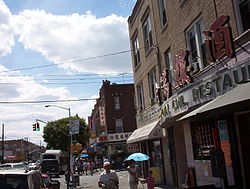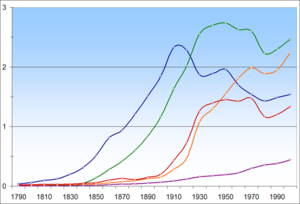- Demographics of Brooklyn
-
Population trend[1] Year Inhabitants 1731 2,150 1756 2,707 1771 3,623 1786 3,966 1790 4,549 1800 5,740 1810 8,303 1820 11,187 1830 20,535 1840 47,613 1850 138,822 1860 279,122 1870 419,921 Year Inhabitants 1880 599,495 1890 838,547 1900 1,166,582 1910 1,634,351 1920 2,018,356 1930 2,560,401 1940 2,698,285 1950 2,738,175 1960 2,627,319 1970 2,602,012 1980 2,230,936 1990 2,300,664 2000 2,465,326 2010 2,504,700 The demographics of Brooklyn are very diverse, with the borough being a melting pot for many cultures.
According to the 2010 Census, 35.7% of the population was non-Hispanic White, 31.9% non-Hispanic Black or African American, 10.4% non-Hispanic Asian, 0.4% from some other race (non-Hispanic) and 1.6% of two or more races (non-Hispanic). 19.8% of Brooklyn's population was of Hispanic, Latino, or Spanish origin (they may be of any race).
As of the census[2] of 2000, there are 2,465,326 people, 880,727 households, and 583,922 families residing in Brooklyn (New York City). The population density was 13,480/km² (34,920/mi²). There were 930,866 housing units at an average density of 5,090/km² (13,180/mi²). If the boroughs of New York City were separate cities, Brooklyn would be the third largest city in the United States after Los Angeles and Chicago. According to an estimate of the United States Census Bureau, Brooklyn's population increased to 2,486,235 in 2005.
Contents
Households
Of its 880,727 households 33.3% have children under the age of 18 living in them, 38.6% were married couples living together, 22.3% had a female householder with no husband present, and 33.7% were non-families. Of all households 27.8% are made up of individuals and 9.8% had someone living alone who was 65 years of age or older. The average household size was 2.75 and the average family size was 3.41.
In the County the population was spread out with 26.9% under the age of 18, 10.3% from 18 to 24, 30.8% from 25 to 44, 20.6% from 45 to 64, and 11.5% who are 65 years of age or older. The median age is 33 years. For every 100 females there were 88.4 males. For every 100 females age 18 and over, there were 83.1 males.
Income
The median income for a household in the County was $32,135, and the median income for a family was $36,188. Males had a median income of $34,317 versus $30,516 for females. The per capita income for the County was $16,775. About 22.0% of families and 25.1% of the population were below the poverty line, including 34.0% of those under age 18 and 21.5% of those age 65 or over.
Race and ethnicity
According to the 2009 American Community Survey, White Americans made up 46.6% of Brooklyn's population; non-Hispanic whites made up 36.9% of the population. Black Americans made up 34.2% of Brooklyn's population; non-Hispanic blacks made up 32.9% of the population. Native Americans made up 0.3% of Brooklyn's population. Asian Americans made up 9.5% of the population; Pacific Islander Americans made up 0.1% of the populace. Multiracial Americans made up 1.4% of Brooklyn's population. Hispanic and Latino Americans made up 19.6% of Brooklyn's population.[3]
European Americans
According to the 2009 American Community Survey, white Americans made up a plurality (46.6%) of Brooklyn's population, of which 36.9% are non-Hispanic whites. Whites (both Hispanic and non-Hispanic) number near 1.2 million individuals, and there are nearly 950,000 non-Hispanic whites residing in Brooklyn. Brooklyn's European American population mainly consists of ethnic Europeans who are either from or descendants from Eastern and Southern European countries of Italy, Russia, Poland, Albania, and former Soviet Union countries, as well as Ireland. Southern and Western Brooklyn is predominantly European American, and most of the borough's European American residents are of the Catholic or Jewish faith. Amongst Catholics, Italian Americans are the predominant ethnic group in neighborhoods such as Bensonhurst, Dyker Heights, Carroll Gardens, Gravesend and Manhattan Beach; Polish Americans are the predominant ethnic group in neighborhoods such as Greenpoint and Greenwood Heights; Russian Americans are the predominant ethnic group in neighborhoods such as Brighton Beach and Sheepshead Bay; and Irish Americans are the predominant ethnic group in neighborhoods such as Bay Ridge, Gerritsen Beach, and Marine Park. Amongst Jews, Brooklyn is 15.4% Jewish[citation needed] with Jews being the predominant ethnic group in neighborhoods such as Borough Park, Williamsburg, Midwood, and Ocean Parkway. Neighborhoods surrounding Bedford-Stuyvesant such as Brownsville, Canarsie, and East New York were previously majority Italian and Jewish but have in the 20th century shifted into majority Black and Puerto Rican communities [4] With the demographic shift that occurred between the 1950s and 1970s, the crime rate in Brooklyn increased and the borough lost almost 500,000 people, most of them White.[5] Those residents moved to neighboring boroughs of Queens and Staten Island, in addition to suburban counties of Long Island and New Jersey.
According to the 2009 American Community Survey, the six most common European ancestries were the following.[6]
Ancestry Number % of total population Italian 157,068 6.1% Russian 100,923 3.9% Irish 88,766 3.5% Polish 71,099 2.8% German 53,188 2.1% English 36,174 1.4% African Americans
According to the 2009 American Community Survey, African Americans made up over one-third (34.2%) of Brooklyn's population. There are over 877,000 African Americans residing in Brooklyn. The historical cultural center of the borough has long been Bedford-Stuyvesant; African Americans became a majority in Bedford-Stuyvesant in the 1930s following the construction of the A line subway between Harlem and Bedford.[7] Neighborhoods surrounding Bedford-Stuyvesant in Northern and Eastern Brooklyn are also majority African American such as Brownsville, Canarsie, Crown Heights, East Flatbush, Prospect Lefferts-Gardens, East New York, Coney Island and Fort Greene. Together these neighborhoods have a population of about 940,000 and are roughly 82% African American, making it the largest black community in the United States. [8] The roads of Eastern Parkway, Malcolm X Boulevard, Kings Highway, Broadway, Atlantic Avenue, Linden Boulevard, Flatlands Avenue and Jackie Robinson Parkway connect several of these neighborhoods. In addition, Blacks make up a substantial percentage of the residents in public housing throughout the borough.
Caribbean Americans
According to the 2010 US Census data on brooklyn.com there are approximately 370,000 (16.4%) Caribbean descendants in brooklyn. That figure includes persons who identify with the Dominican Republic (3.3%), but does not include the (7.4%) Puerto Rican population. Including Puerto Ricans there are approximately 560,000 (23.8%) persons of caribbean descent in Brooklyn. Similar, but not identical demographics in America can be found in Miami, but there are not as many Cubans in New York.
Hispanics and Latinos
According to the 2009 American Community Survey, Hispanics and Latinos made up nearly one-fifth (19.6%) of Brooklyn's population. Over 500,000 Hispanics and Latinos reside in Brooklyn. Nearly 190,000 Puerto Ricans call the borough home, and they make up 7.4% of the population. The borough's 91,000 Mexican Americans make up 3.6% of its population. Many neighborhoods in Eastern and Northern Brooklyn are home to a high number of Hispanics mainly from Puerto Rico, the Dominican Republic, and Central America. Hispanics are mainly concentrated in neighborhoods in the East and Northeast sections of Brooklyn. Hispanics have become the majority in former black neighborhoods such as Bushwick, East Williamsburg and Cypress Hills. Sunset Park, in South Brooklyn is also home to a large Hispanic community.
Asian Americans
According to the 2009 American Community Survey, Asian Americans made up 9.5% of the Brooklyn's population. Over 243,000 Asians live in the borough. The most numerous Asian American group are those of Chinese descent. Chinese Americans make up 6.4% of the borough's population, and they number over 163,000 individuals. Much of Brooklyn's Asian population is concentrated in Southern Brooklyn neighborhoods such as Sunset Park, and Homecrest. The Chinese were second only to Queens among New York boroughs, meaning Manhattan's Chinatown is no longer the main residence of Chinese in the city. Approximately 19,851 Asian Indians live in Brooklyn. Approximately 9,681 Filipino Americans live in Brooklyn. Approximately 6,977 Korean Americans reside here. Brooklyn has the most Vietnamese Americans of any borough, they numbered over 5,700 individuals. The 4,704 Japanese Americans rounded out Asian American groups with over 1,000 people in Brooklyn.
Language
Brooklyn has a high degree of linguistic diversity. In the 2000 United States Census 46.7% of the population reported speaking a language other than English at home (either exclusively or in addition to English).[9] The most prevalent other language identified was Spanish, spoken at home by 18.00% of the population. Additionally, 5.95% of the population reported speaking Russian, 4.19% Haitian-French or a Haitian Creole language, 3.92% Chinese, 3.10% Yiddish, 2.10% Italian, 1.42% Polish, 1.13% Hebrew, and 1.09% Arabic. Other languages spoken at home by at least 5000 people include Cantonese, Urdu, Bengali, Greek, Korean, Tagalog, and Albanian.[10]
References
- ^ ""Notes Geographical and Historical, relating to the Town of Brooklyn, i" by Gabriel Furman and Paul Royster (transcriber & depositor)". Digitalcommons.unl.edu. 2006-03-21. http://digitalcommons.unl.edu/libraryscience/30/. Retrieved 2010-12-22.
- ^ "American FactFinder". United States Census Bureau. http://factfinder.census.gov. Retrieved 2008-01-31.
- ^ American FactFinder, United States Census Bureau. "Kings County, New York - ACS Demographic and Housing Estimates: 2009". Factfinder.census.gov. http://factfinder.census.gov/servlet/ADPTable?qr_name=ACS_2009_1YR_G00_DP5&geo_id=05000US36047&ds_name=&_lang=en. Retrieved 2010-12-22.
- ^ The Tipping Point, article copied from The New Yorker, June 3, 1996
- ^ The Ungovernable City: John Lindsay and His Struggle to Save New York
- ^ American FactFinder, United States Census Bureau. "Kings County, New York - Selected Social Characteristics in the United States: 2009". Factfinder.census.gov. http://factfinder.census.gov/servlet/ADPTable?_bm=y&-geo_id=05000US36047&-qr_name=ACS_2009_1YR_G00_DP2&-context=adp&-ds_name=&-tree_id=309&-_lang=en&-redoLog=false&-format=. Retrieved 2010-12-22.
- ^ Bed-Stuy on the Move
- ^ "11203 - Fact Sheet - American FactFinder". Factfinder.census.gov. http://factfinder.census.gov/servlet/SAFFFacts?_event=ChangeGeoContext&geo_id=86000US11203&_geoContext=01000US%7C04000US36%7C05000US36047&_street=&_county=&_cityTown=&_state=04000US36&_zip=11203&_lang=en&_sse=on&ActiveGeoDiv=geoSelect&_useEV=&pctxt=fph&pgsl=010&_submenuId=factsheet_1&ds_name=DEC_2000_SAFF&_ci_nbr=null&qr_name=null®=null%3Anull&_keyword=&_industry=. Retrieved 2010-12-22.
- ^ DP-2. Profile of Selected Social Characteristics, Census 2000 Summary File 3 (SF 3), Kings County, New York, U.S. Census Factfinder website
- ^ 2000 Census data for Kings County, New York, retrieved from the MLA Language Map Data Center, November 3, 2010
Categories:
Wikimedia Foundation. 2010.


